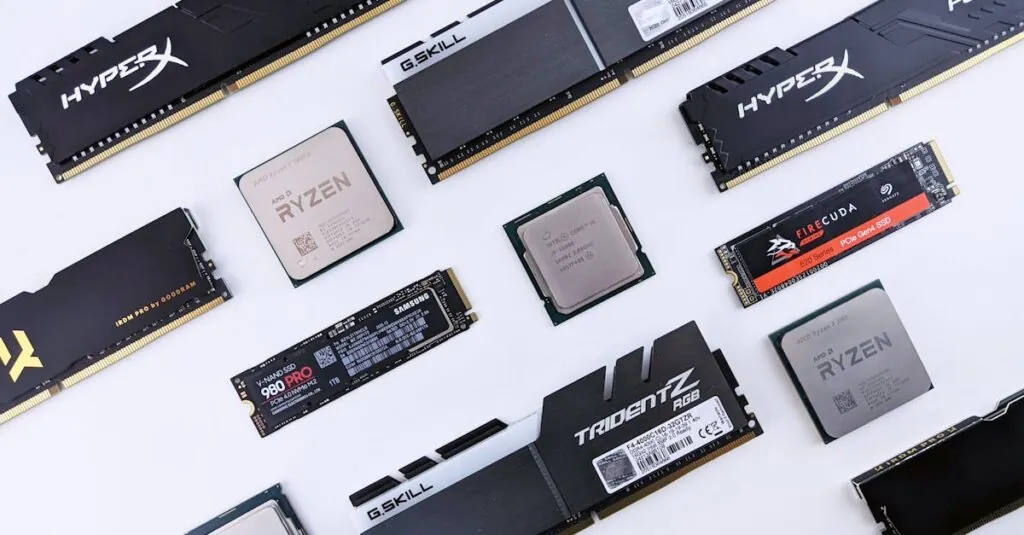In the ever-evolving world of tech, M.2 storage technology is like the sleek sports car zooming past traditional hard drives. It’s compact, lightning-fast, and ready to take your computing experience to the next level. If you’ve ever felt the frustration of waiting for files to load or programs to launch, M.2 is here to rescue you from the clutches of sluggish performance.
Imagine a world where your computer boots up faster than you can say “SSD.” With M.2, that dream becomes a reality. This innovative storage solution not only saves space but also delivers impressive read and write speeds that’ll make your old hard drive feel like it’s stuck in traffic. Buckle up as we dive into the fascinating world of M.2 technology and discover why it’s the upgrade your system’s been begging for.
Table of Contents
ToggleOverview of M.2 Storage Technology
M.2 storage technology stands out for its compact form factor and impressive performance. This technology supports multiple interface protocols, including SATA and NVMe, providing flexible options for various applications. Increased data transfer rates significantly outperform traditional hard drives and even some SATA SSDs.
Form factors for M.2 devices typically utilize lengths of 30mm, 42mm, 60mm, 80mm, and 110mm. Smaller dimensions allow M.2 drives to fit into tighter spaces, making them ideal for ultra-thin laptops and compact desktops. Enhanced thermal management features within M.2 drives prevent overheating during heavy workloads, ensuring consistent performance.
Performance benchmarks highlight M.2’s advantages, with NVMe drives reaching speeds over 3,000 MB/s, vastly improving load times for applications and files. Those transitioning to M.2 often experience faster boot times and reduced waiting periods when launching programs. Installing M.2 drives is straightforward, as they utilize a simple slot connection on motherboards.
Versatility is another strong point of M.2 technology, serving various use cases from gaming to data centers. Heavily utilized in modern computing environments, M.2 drives cater to users requiring high speed and efficiency. Features such as end-to-end data protection and encryption add layers of security, further enhancing their appeal.
This technology represents a significant leap forward for storage solutions, making it essential for anyone looking to boost their computer’s performance. High reliability coupled with increasing capacities ensures that M.2 remains a preferred choice in the evolving landscape of data storage technology.
Advantages of M.2 Storage Technology
M.2 storage technology offers several notable benefits that enhance computing experiences.
Increased Speed and Performance
Speed stands out as a primary advantage of M.2 technology. NVMe drives achieve transfer rates exceeding 3,000 MB/s, significantly outpacing traditional hard drives and SATA SSDs. Faster read and write speeds translate into quicker boot times and reduced waiting for program launches. M.2 drives excel in heavy workloads, maintaining high performance levels even during intensive tasks. Enhanced thermal management features also help regulate temperature, preventing overheating. Users benefit from an overall smoother computing experience because of these performance improvements.
Compact Form Factor
Compact form factor shapes M.2’s versatility. Its design accommodates various lengths, making it ideal for space-constrained devices like ultra-thin laptops and compact desktops. This feature enables manufacturers to create slimmer devices without sacrificing storage capacity or performance. Flexible installation options, including compatibility with multiple interface protocols like SATA and NVMe, further enhance its adaptability. M.2 technology integrates seamlessly into a wide range of systems, allowing users to maximize their available space while enjoying superior performance.
Types of M.2 Interfaces
M.2 storage technology supports various interfaces, including SATA and NVMe, each offering unique benefits. Understanding these interfaces helps users choose the right option for their needs.
SATA vs. NVMe
SATA interfaces provide standard data transfer rates, typically up to 600 MB/s. In contrast, NVMe technology significantly enhances performance by leveraging PCIe lanes, achieving speeds exceeding 3,000 MB/s. Users looking for fast boot times and responsive applications will find NVMe to be superior. While SATA remains suitable for basic tasks, NVMe excels in heavy workloads and larger data transfers. A notable difference exists in latency, with NVMe reducing delays during read and write processes, making it ideal for gaming and professional applications.
PCIe Lanes Explained
PCIe lanes are crucial for determining the performance of M.2 drives. Each lane facilitates a data transfer rate of 1 GB/s, amplifying overall performance based on the number of lanes utilized. M.2 drives typically support one to four PCIe lanes, directly impacting speed. Users should note that more lanes equal higher potential speeds, enhancing multitasking capabilities. For instance, a drive using four lanes can achieve maximum throughput of about 4,000 MB/s, significantly outperforming single-lane devices. This functionality makes M.2 drives an excellent option for advanced computing needs.
Compatibility and Installation
M.2 storage technology integrates easily with various systems, but compatibility with existing hardware remains crucial. Understanding the specific requirements helps ensure optimal performance.
Choosing the Right M.2 Drive
Selecting an appropriate M.2 drive depends on specific needs and device compatibility. Consider the interface type, either SATA or NVMe; NVMe drives significantly outperform SATA drives with speeds exceeding 3,000 MB/s. Check your motherboard to confirm support for the interface needed, ensuring it has the necessary M.2 slot configuration. Evaluate storage capacity as well, with options ranging from 120 GB to several terabytes. Each option suits different applications, whether casual gaming or high-performance tasks.
Installation Process
Installing an M.2 drive simplifies the upgrade process. Begin by powering down the device and opening the case. Locate the M.2 slot on the motherboard, gently aligning the drive with the connector at a slight angle. Press down to secure it in place, fastening it with the provided screw. After installation, close the case and reconnect power. Boot the system to ensure proper recognition of the new drive. Following this process guarantees an efficient upgrade, significantly enhancing storage performance.
Future of M.2 Storage Technology
M.2 storage technology is set to evolve rapidly, with improvements in speed and efficiency likely driving future developments. Researchers focus on increasing data transfer rates even further, leveraging advancements in PCIe technology. New M.2 drives hint at the potential for speeds exceeding 6,000 MB/s, accommodating the demands of high-performance gaming and data-intensive applications.
Emerging protocols like PCIe 5.0 offer significant enhancements, doubling the bandwidth available for M.2 drives. This increase in data lanes allows manufacturers to create drives that can handle more simultaneous operations, thus optimizing performance. Additionally, the integration of artificial intelligence in storage management increases efficiency, enabling smarter data prioritization.
Energy efficiency becomes critical as data centers expand, and sustainable materials may emerge for M.2 drive production. Environmental considerations influence manufacturing practices, as consumers increasingly prefer eco-friendly technology. Security measures will also advance, with improved encryption methods becoming standard to address growing data privacy concerns.
Compatibility and standardization will continue to play essential roles in M.2’s future, ensuring seamless integration across various devices. As form factors evolve, ultra-compact designs will meet the needs of increasingly slim devices without sacrificing performance or storage capacity.
Lastly, adoption in diverse sectors such as edge computing and cloud services emphasizes the versatility of M.2 technology. Organizations will leverage M.2 drives to optimize performance in areas like real-time data processing and analytics, further solidifying their importance in the tech landscape.
Conclusion
M.2 storage technology is revolutionizing the way data is stored and accessed. Its compact design and impressive speed make it a game-changer for various computing environments. As users demand faster boot times and improved performance, M.2 drives are quickly becoming the go-to solution for both casual users and professionals alike.
The versatility of M.2 technology ensures it meets the needs of diverse applications from gaming to enterprise solutions. With ongoing advancements in speed and efficiency, M.2 is poised to remain at the forefront of storage innovation. As the tech landscape evolves, embracing M.2 will be essential for anyone looking to enhance their computing experience.





